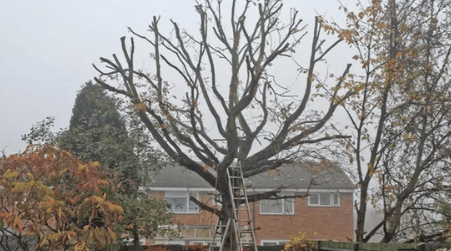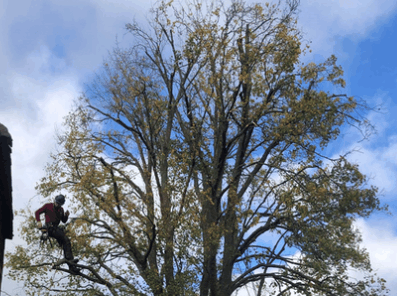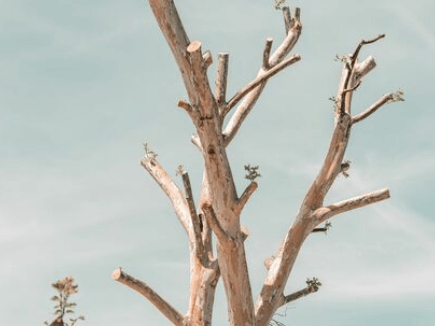
We owe trees a huge debt of gratitude, as they do so much for us and ask little in return. So, the least we can do is keep trees healthy and help them live longer.
And one way we can do this is through proper pruning.
The trouble is that some pruning methods can be harmful, so it's essential to understand the rights and wrongs in order to avoid harming your trees, perhaps fatally!
As we continue the Tree Surgeon Pro blog series on tree care, we're turning our attention to two tree-trimming methods in particular: tree topping vs crown reduction.

Imagine you’re looking up at a tree in your garden. It’s a beauty; mature, full of character, but lately it’s started to look a bit overgrown. Maybe it's blocking the light, swaying a bit too dramatically in strong winds, or just starting to feel out of proportion in the space it’s in. This is where crown reduction comes into play.
Crown reduction is a professional tree pruning technique used to reduce the overall tree size and spread of a tree’s canopy, with the tree's “crown” being the upper part of the tree made up of branches and leaves. The goal is to make it more manageable, balanced, and safe, without ruining the tree's natural shape or health.
It's not just a hack-job where the top gets lopped off - far from it! Done properly, crown reduction is a skilled and selective process, carefully trimming back the outermost branches to reduce the tree's height and width, while maintaining the tree’s structural integrity and aesthetic appeal.

There are a few common reasons for using this method:
Sometimes, trees simply outgrow the space they were planted in, particularly in urban or suburban settings where room is limited. As they mature, their size can start to overwhelm gardens, pavements, or nearby structures. Crown reduction helps to manage a tree's growth in a way that’s sympathetic to both the tree and its surroundings.
Large branches can become hazardous over time, especially during high winds or storms. If left unchecked, they may snap or fall, posing a risk to people, property, or vehicles. By reducing the weight and spread of the crown, this method can improve the tree’s structural stability and reduce the likelihood of breakages.

Trees naturally cast shade, but when they become too dense or oversized, they can block out valuable sunlight. This might affect your home, garden, or other plants competing for light and air. Crown reduction helps open things up, letting more light filter through while still preserving the character of the tree.
If a tree has suffered storm damage or has been affected by disease or decay, crown reduction can help bring back a sense of balance and vitality. Removing affected limbs in a controlled way encourages healthier regrowth and can extend the life of the tree.
A qualified arborist will carefully select which branches to cut back, typically reducing to the lateral branches (that’s a smaller branch that forms part of the tree’s structure). The aim is to keep the tree’s natural shape, avoid creating flat tops or unsightly stumps, and most importantly, ensure the cuts are clean and don’t cause long-term damage.
A rule of thumb is to remove no more than 20–30% of the crown in one go, depending on the species and health of the tree. It's important to note that over-pruning can seriously weaken a tree and leave it vulnerable to disease!
Absolutely - if it's handled correctly! Improper pruning can do more harm than good.
Mature trees should never be pruned too harshly, but occasional crown reduction will vastly improve their health.
Crown reduction is beneficial as it reduces stress on heavy limbs, improves air circulation, and helps prevent breakage. But it must be carried out with care and precision, and that takes training, skill, knowledge and experience.

If you've read some of our other blogs, you might have a clue about Tree Surgeon Pro's feelings about tree topping. For those who haven't, let's get things out in the open: we don't like it.
So, when discussing tree topping vs crown reduction, you might have an idea already as to which one, in our opinion, is the clear winner!
Why do we feel so strongly? To answer this, here's an in-depth explanation of the process...
At first glance, tree topping - sometimes called hat-racking - might sound like a quick and easy fix. You've got a tree that's grown too tall, blocking light or brushing dangerously close to power lines, so the idea of simply “lopping off the top” might seem like a logical solution. But in reality, topping is one of the most damaging things you can do to a tree.
This method involves reducing the canopy by cutting back the upper portion of a tree’s main branches, often quite drastically. This creates a distinctive, if ugly, stunted shape resembling a hat rack, hence the alternative name.
Instead of reducing the crown selectively and thoughtfully (as with crown reduction), topping simply removes the tree’s upper limbs, including the entire crown, with little regard for structure, natural form, or future growth.
It’s a severe approach to tree management, and, unfortunately, it's still far too common!

Usually, it comes down to one of four things:
But here's the truth: topping doesn't solve these problems. It creates new ones!
If you think the Tree Surgeon Pro team's dislike of tree topping is unjustified, take a moment to read these facts about this harmful process...
Topping strips away large portions of the tree’s leaf-bearing crown, often right down to the next lateral growth (and sometimes further). Leaves are how a tree makes its food, and without this foliage, it’s essentially starving. This puts the tree under significant stress, and it responds by pushing out weak, spindly shoots in a desperate attempt to recover, but these are far more vulnerable to pests and disease.
Topping doesn't just change the look of a tree, it butchers it! The natural, balanced form is lost, often leaving it looking stubby, awkward and unnatural, with stunted growth. And those rapid new shoots that sprout up? They grow in haphazard clusters, completely ruining the tree’s original structure.

The new shoots that emerge after topping are weakly attached and prone to snapping. Over time, as they grow, they become even more likely to fall than the original branches ever were. So while topping might feel like a short-term fix for safety, it actually increases the risk in the long run.
Large, open wounds left by drastic cuts don’t heal well. Aside from causing significant shock, they create perfect entry points for fungi, bacteria, insect attack and other pests. Often, these wounds lead to internal decay, which may not be obvious until there is irreversible or severe damage.
If a tree is topped severely and its resources are already limited, the stress can be too much. Many topped trees go into decline and die prematurely, all because of poor pruning decisions.
The only time a professional arborist would suggest tree topping is in cases where the tree has been damaged by a natural disaster and there's no alternative.
At Tree Surgeon Pro, we offer specialist tree services, meaning that we can tackle any type of tree care work, whether it's in a garden, park, or so-called city-owned trees in urban streets.
We have vast experience in managing trees of all kinds, offering services such as:
When you need help and advice, always ask a professional arborist or tree surgeon. At Tree Surgeon Pro, we're always happy to oblige, so don't hesitate to call and see how our services can benefit you and your trees!